Complete Guide to Heel Scraper Tool: Function, Use, Care
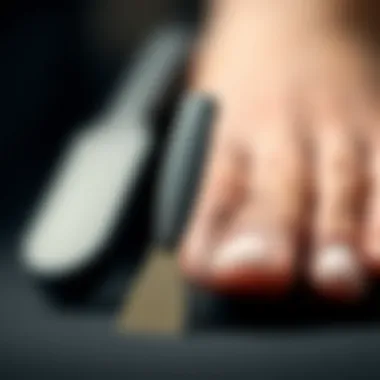
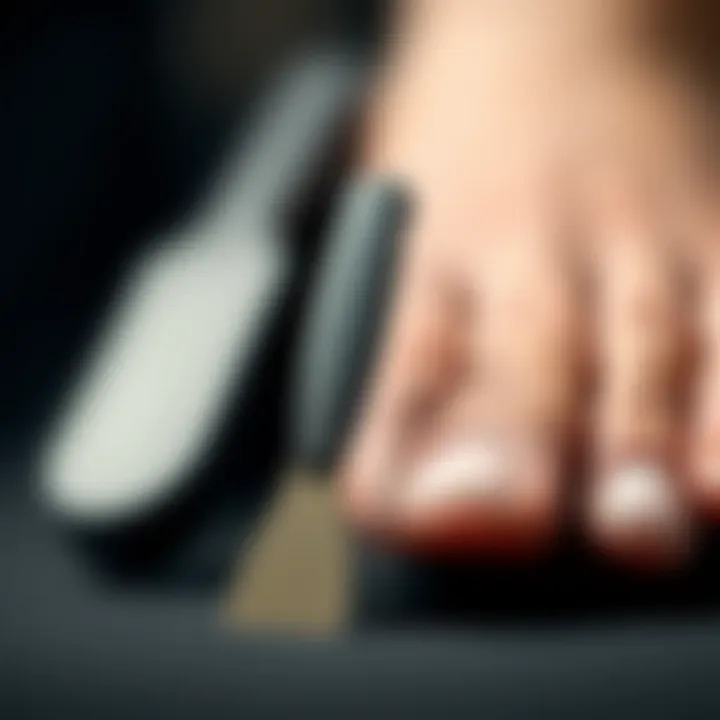
Intro
Foot health often gets overshadowed by other aspects of personal care, yet it plays a crucial role in overall well-being. Among the various tools available for maintaining foot hygiene, the heel scraper stands out as an essential instrument for many. Understanding how to use this tool can significantly impact foot comfort and health, making it a worthy addition to everyone's grooming kit. In this guide, we will explore what a heel scraper is, how it works, and tips for proper usage and maintenance.
Functionality of the Heel Scraper Tool
The heel scraper is designed specifically to remove dead skin and rough patches from the heels and soles of the feet. By utilizing various levels of abrasiveness, it can effectively smoothen rough spots. It’s not simply about aesthetics; removing dead skin can prevent issues such as cracking and blistering, translating to less pain and greater mobility.
Types of Heel Scrapers
Heel scrapers come in diverse designs and materials. Understanding these variation helps in selecting the right tool. Some common types include:
- Metal Heel Scrapers: Often crafted from stainless steel, these are durable and provide efficient exfoliation. However, they require care to avoid skin damage.
- Foot Files: Usually made from plastic or wood with a rough surface, they are gentler and perfect for everyday use.
- Pumice Stones: While they serve a similar function, pumice is more natural and can be less abrasive on sensitive skin.
Choosing the Right Tool
Selecting the appropriate heel scraper can depend on various factors such as skin sensitivity, existing foot conditions, and personal comfort levels. Those with sensitive skin should consider using plastic foot files or pumice stones over metal scrapers to minimize risks of injury.
Usage Tips
Using a heel scraper effectively requires a bit of technique to ensure safety and maximize benefits. Here are some pointers:
- Preparation: Soak your feet in warm water for 10-15 minutes. This softens dead skin and makes it easier to remove.
- Drying: Gently dry your feet after soaking; this helps maintain grip on the scraper.
- Technique: Use light pressure, making short strokes in one direction to prevent skin irritation and achieve a balanced result.
- Frequency: Scraping your heels once a week could be sufficient for most people. Overuse can lead to skin issues.
- Moisturizing: After scraping, applying a good foot cream will help to nourish and protect the skin.
Maintenance of the Heel Scraper Tool
Taking proper care of your heel scraper prolongs its lifespan and ensures effective performance. Here are some best practices for maintenance:
- Cleaning: Rinse the scraper after each use to remove dead skin and bacteria. For metal versions, consider a disinfectant wipe or a quick soak in soapy water.
- Storage: Keep the scraper in a dry place. A pouch or a designated space in your bathroom keeps it clean and prevent damage.
- Inspection: Regularly check for any signs of wear, especially in metal scrapers, which can develop nicks or dulled edges over time.
Keeping your heel scraper in top condition not only enhances its performance but also your overall foot care routine.
Finale
Proper usage and care of the heel scraper tool can transform how you manage foot health. This simple yet effective tool plays a vital role in ensuring your feet remain smooth and healthy. Incorporating a heel scraper into your regular foot care regimen can bring comfort in every step you take. Whether it's for preventing serious conditions like calluses or improving overall aesthetic appeal, understanding its functionality, usage, and maintenance is essential.
You can explore more about foot care practices on platforms such as Wikipedia, Britannica, and community forums like Reddit.
Let's keep those feet happy!
Understanding the Heel Scraper Tool
The heel scraper tool isn't just another gadget for foot care; it's an essential implement designed to help maintain healthy and attractive feet. Understanding this tool thoroughly is crucial for anyone keen on foot aesthetics and hygiene. The key lies not only in its physical appearance but rather in how it operates, the materials from which it's made, and the benefits it delivers to its users.
Definition and Purpose
The heel scraper is often a small, handheld tool specially designed to remove toughened skin, calluses, and other build-ups from the heel and foot areas. Think of it as a secret weapon in your foot care routine. It often boasts a textured surface, allowing for effective exfoliation. Its primary purpose is to keep your feet smooth, tidy, and free from painful cracking, which can come from neglect.
Managing dry skin on the heels is vital not just for comfort’s sake but also for preventing potential infections. When those hard layers get too thick, they can lead to fissures, which, if untreated, may require medical attention. Investing in a quality heel scraper allows individuals to take an active role in their foot health — a proactive approach that can save both time and money down the line.
History and Evolution
The heel scraper has a rather rich history that goes back centuries. Originally, tools for foot care were quite rudimentary, often made from natural materials such as wood and stone. Ancient civilizations, including the Egyptians, used various methods to maintain foot hygiene, although detailed records are scarce. Fast forward to the 19th century; foot care tools began to pop up in beauty salons, particularly in Europe. This was an era when personal grooming was becoming a social norm, and having well-tended feet was a reflection of overall hygiene and societal status.
As technology advanced, so did the design and materials of heel scrapers. Nowadays, you'll find them manufactured from various materials like stainless steel, plastics, and even eco-friendly options. This evolution reflects a growing awareness about foot health and a demand for effective personal grooming solutions. The focus has also shifted towards ergonomics, with many modern designs ensuring that users can scrape away dead skin with minimal effort, reducing strain on the hands and wrists.
"Understanding the history of the heel scraper tool helps appreciate the innovations that prioritize comfort and efficiency in foot care."
In essence, knowing both the definition and the evolution of the heel scraper tool paves the way for effective usage. It’s not merely a leftover from simpler times; it’s a practical instrument that continues to evolve alongside our understanding of health and beauty routines.
Design Features
The design features of the heel scraper tool hold significant weight in its functionality and user experience. A well-thought-out design not only enhances effectiveness but also promotes safety and comfort during use. In the competitive realm of foot care tools, understanding these aspects is crucial for anyone interested in high-quality personal grooming.
Material Composition
The material composition of a heel scraper is foundational to its performance and durability. Most commonly, these tools are made from stainless steel or high-grade plastic.
Stainless steel offers several advantages:
- Durability: It withstands wear and tear better than many other materials, ensuring longevity.
- Hygiene: It's easy to clean and less prone to harboring bacteria, which is essential for foot care.
- Precision: The sleek edge of a steel blade provides effective scraping without excessive pressure.
On the other hand, plastic scrapers can be lightweight and often have a more ergonomic design. They may come in vibrant colors, which can be attractive for certain users. However, when considering durability and effectiveness, the benefits of stainless steel typically outweigh those of plastic.
Ergonomic Aspects
Ergonomics play a critical role in the usability of heel scrapers. The best tools are designed to fit comfortably in hand, allowing for optimal grip and control. Features that contribute to a good ergonomic design include:
- Handle Design: A handle that provides a comfortable grip prevents slipping and reduces the strain on hands, especially during prolonged use.
- Weight Distribution: Ideal scrapers maintain a balance that does not strain the wrist or fingers. A lightweight scraper with a well-placed center of gravity significantly enhances usability.
Moreover, some scrapers come with non-slip grips, which are especially beneficial when used on wet feet post-soak.
Blade Types
The type of blade is arguably one of the most critical design features of a heel scraper. Different blade types offer various advantages, depending on personal needs and foot conditions. Here are some common blade types:
- Flat Blades: These are typically found in more traditional scrapers. They provide a broad scraping surface that may be more effective on stubborn calluses but require more force.
- Curved Blades: They follow the natural contours of the foot, making them suitable for detailed work around the heels and sides of the feet.
- Interchangeable Blades: Some advanced models allow users to switch out blades based on specific needs or foot conditions. This versatility can prove invaluable in tailoring the tool to individual preferences.
"A good heel scraper tool combines the right materials, ergonomic design, and blade types to significantly improve foot care at home."
How to Use the Heel Scraper Tool
Understanding how to properly use a heel scraper tool is essential for achieving optimal results in foot care. This is no mere accessory; it plays a crucial role in maintaining foot health, enhancing comfort, and improving aesthetics. A well-executed scraping can alleviate the discomfort caused by calluses and dryness, while also providing an opportunity to foster a regular foot care routine. Let's break down the steps to make the most of your heel scraper tool.
Preparing Your Feet
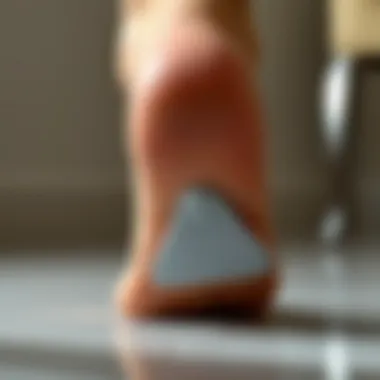
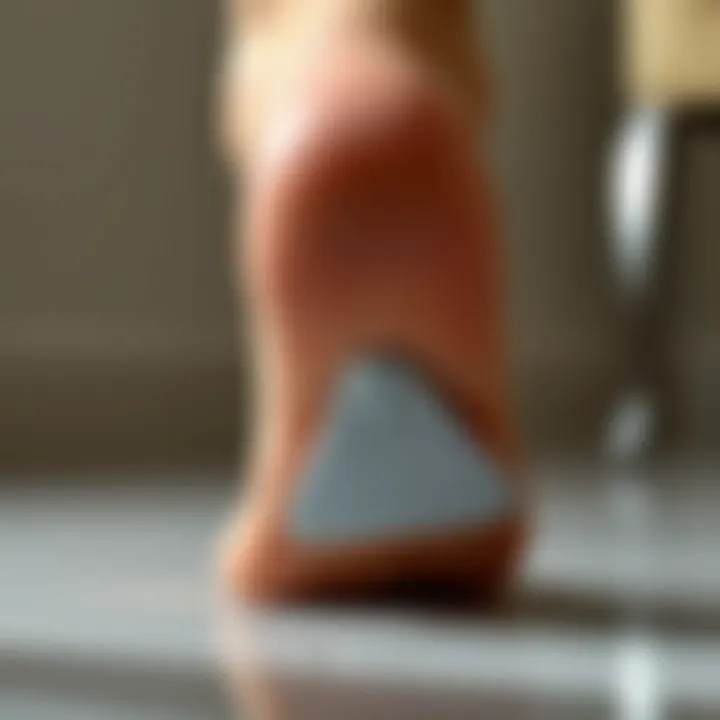
Before one can embark on the scraping journey, it is vital to prepare the feet adequately. A little preparation goes a long way in ensuring efficacy and safety. Here’s how to do it:
- Choose the Right Time: Preferably, scrape your heels after a warm shower or bath. This helps soften the skin and opens up the pores, making it easier to remove dead skin.
- Thoroughly Wash Feet: Use a mild soap to clean your feet. Make sure to rinse well and dry them properly with a towel, particularly between the toes. This ensures there’s no debris or moisture left that could cause irritation during scraping.
- Inspect the Feet: Take a good look at your heels and feet. Identify areas that require attention, such as particularly thick calluses or spots that might need more focused scraping.
"Nuanced care often leads to nuanced results; don’t skip the prep work!"
Scraping Techniques
Once the feet are ready, the next step is applying the heel scraper tool correctly. Mastering the right techniques will not only yield better results but also prevent any potential injuries. Here are some valued techniques:
- Hold the Tool Properly: Grip the scraper firmly but gently. Ensure it’s at an angle that feels comfortable to the hand.
- Use Controlled Movements: Move the scraper back and forth with moderate pressure. Avoid pressing down too hard to prevent skin irritation. For any thick patches of skin, you might need to apply slightly more pressure, but be cautious.
- Follow the Contours of the Foot: Always scrape in the direction that follows the contour of your foot. Avoid harsh scrubbing; think more along the lines of polishing rather than chiseling away at the surface.
- Take Breaks: If you feel any discomfort, pause. Scraping should be a gentle, almost meditative process. If you’re working through tougher areas, it might require more patience.
Post-Care Routine
After using the heel scraper tool, post-care is crucial. Neglecting this step can undo all the good work achieved. Here's how to follow-up:
- Clean the Feet Again: Once done scraping, rinse your feet to wash off any residual skin flakes. Dry them carefully, paying attention to moisture between the toes.
- Moisturize: Apply a quality moisturizer or foot cream to your feet. This replenishes hydration and helps maintain soft skin. Aim for lotions with ingredients like shea butter or glycerin for optimal moisture retention.
- Monitor for Any Adverse Reactions: Keep an eye on your feet for signs of irritation or rash. If you notice any unusual developments, it might be time to reconsider your technique or frequency of use.
- Regular Maintenance: For best results, make heel scraping a regular part of your foot care routine, perhaps once a week for typical maintenance.
Benefits of Regular Use
The heel scraper tool is not just a gadget that spends most of its time nestled in the corner of your bathroom. Using it regularly can lead to noticeable improvements in foot health, comfort, and even aesthetic appeal. This section dives into how incorporating the heel scraper into your foot care routine can yield significant benefits.
Improved Foot Health
Taking care of your feet is often overlooked, yet it's vital for overall well-being. The improved foot health that comes with regular use of a heel scraper is remarkable. By removing dead skin and calluses, you can prevent painful conditions such as corns or cracks that can lead to infections. Many folks don’t realize that healthy skin on the feet is just as important as on any other part of the body. You wouldn’t let your skin dry out on your face, would you?
Using a heel scraper helps rejuvenate the skin, promoting increased blood flow which is essential for regeneration. It’s like giving your feet a mini-spa day in the comfort of your own home. Prospective buyers don’t neglect the necessary upkeep!
Enhanced Comfort
After a long day on your feet, the last thing you want is to feel discomfort from rough patches or calloused areas. Regular use of a heel scraper can transform your experience. Once those rough edges are smoothed away, your shoes will fit better, and you can walk more freely. No one likes the feeling of a shoe that rubs and pinches!
Imagine slipping on your favorite pair without the fear of discomfort. Enhanced comfort isn’t just a luxury; it can improve your productivity and overall mood. It’s true; when your feet feel good, the whole body feels good!
Aesthetic Appeal
Let’s talk about the visual aspect for a moment. Regularly using a heel scraper contributes significantly to the aesthetic appeal of your feet. Smooth heels are invariably more attractive and can boost your confidence, particularly when wearing open-toed shoes or sandals. Who doesn’t like to show off pretty feet in the summer?
"Healthy feet are happy feet. A little care goes a long way in feeling fabulous."
In addition, attending to your feet encourages an inclusive mindset toward self-care. It signifies that you care about your body as a whole. Giving your feet the attention they deserve is frankly non-negotiable when striving for a polished appearance.
In summary, the benefits of regularly utilizing a heel scraper are well worth the time and effort. Improved foot health, enhanced comfort, and aesthetic appeal all work together, resulting in not only happier feet but a more confident you. Incorporating this tool into your routine should be regarded as essential for foot care enthusiasts and anyone wishing to prioritize their personal grooming.
Choosing the Right Heel Scraper Tool
Selecting the right heel scraper tool is paramount, especially if you're genuinely invested in optimizing your foot care routine. It's not just about scraping off dead skin; it's about finding a tool that suits your specific needs and enhances overall foot health. Each individual's foot condition varies, and tools come with diverse features, materials, and designs aimed at distinct purposes. Picking the correct heel scraper can lead to efficient grooming and prevent any missteps that might impact your comfort and health.
When delving into the selection process, consider how different tools can cater to various skin types and concerns. This ensures that your experience is not only effective but also safe—after all, the last thing you want is to make a wrong choice and end up with blisters or irritation instead of smooth heels. With the right heel scraper in hand, you can transform your foot care routine into a much more enjoyable and beneficial experience.
Consideration Factors
There are several key considerations to keep in mind when evaluating heel scrapers. Here’s a breakdown of what to think about:
- Material: Look for scrapers made from durable substances. Stainless steel is often favored for its longevity and ease of cleaning, while ceramic options might appeal for their gentler touch.
- Blade Sharpness: Depending on how tough your calluses are, you might want a sharper blade for a more aggressive treatment or a milder one for sensitive areas.
- Handle Design: Ergonomics matter. A comfortable grip can significantly enhance your scraping experience, especially if you have several areas to tackle.
- Size and Portability: If you're someone who travels often, a compact heel scraper might be suitable.
- Maintenance Requirements: Some tools may require more upkeep than others. Consider how often you’re prepared to clean your tool and what’s involved in the process.
Brand Recommendations
Though many brands produce heel scrapers, a few have garnered attention for their quality and effectiveness. Brands like Scholl and Tweezerman are often discussed among foot care enthusiasts for their reliable products that cater to various foot care needs. These companies produce reliable tools that have been subject to numerous positive reviews, which provides an extra layer of assurance.
Furthermore, Podiatrist’s Choice is often recommended due to its focus on health-oriented designs, ensuring that the scrapers support safe and effective use. Just remember, when choosing a brand, reflect on your personal needs and any specific recommendations from professionals in foot care to arrive at the best decision.
"Choosing the right heel scraper tool not only makes foot care effective but also adds comfort and ease to the process."
Ultimately, the selection of a heel scraper tool boils down to understanding your requirements and how different features can cater to those specifics. Tailored foot care is the best foot care.
Maintenance and Care
Taking care of your heel scraper tool is essential for preserving its effectiveness and longevity. Routine maintenance not only sustains its functionality but also ensures that it remains hygienic and safe to use. When you invest time in proper care, you create a smoother and more enjoyable experience for your foot care routine. Clogged blades or worn-out materials can lead to poor performance, which might ultimately harm your foot health rather than help it.
Cleaning Procedures
Cleaning your heel scraper tool is not just a task, but an essential ritual in maintaining hygiene and effectiveness. A dirty tool can harbor bacteria, which in turn may cause skin infections or irritations. After each use, here’s a simple process to ensure your scraper stays in tip-top shape:
- Rinse Immediately: After using the scraper, rinse it under warm water. This helps remove any skin debris or dead skin cells collected during your session.
- Use Soap or Disinfectant: Apply a mild soap or a disinfecting solution to a soft cloth or sponge. Gently scrub the blade and handle, being careful around any delicate edges.
- Thorough Rinse: Make sure to rinse it thoroughly afterward to remove soap residue.
- Dry Completely: Wipe it down with a clean towel or leave it in a dry area. Avoid letting it air dry in a damp place to prevent any rust or bacteria growth.
Maintaining a clean tool can help enhance your foot care effort.
Storage Solutions
After giving your heel scraper a proper clean, it’s crucial to store it correctly. Where and how you keep it can affect its condition over time. Here are some tips for intelligent storage:
- Dedicated Pouch: Consider using a dedicated pouch or case for your heel scraper. This protects it from dust, dirt, and accidental damage. Look for pouches that are breathable to prevent moisture buildup.
- Avoid Humidity: Store the scraper in a dry place to prevent rust or corrosion on metallic parts. Areas like bathrooms where humidity can affect tools are best avoided.
- Keep Away from Sharp Objects: Avoid placing your heel scraper alongside other tools that might nick or dull the blade. Keeping it separate will maintain its integrity.
A little care and attention in storage go a long way in keeping your heel scraper tool ready for the next foot care session.
Taking consistent steps in maintenance and care can significantly improve the efficiency and lifespan of your heel scraper tool.
By following these cleaning procedures and storage solutions, you not only elongate the life of your tool but also ensure each use contributes positively to your foot health. Remember, taking care of your accessories is as crucial as the act of scraping itself.
Potential Risks and Precautions
When it comes to using the heel scraper tool, it’s vital to understand that like any grooming accessory, there are risks associated with its use. This section aims to illuminate those hazards while providing essential precautions that can mitigate any potential damage.
Skin Sensitivity Considerations
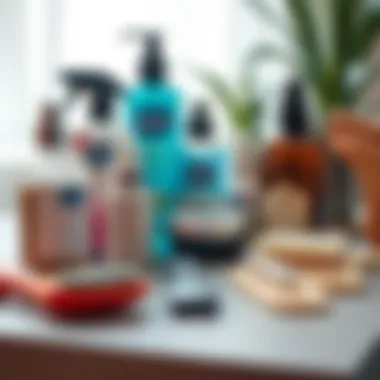
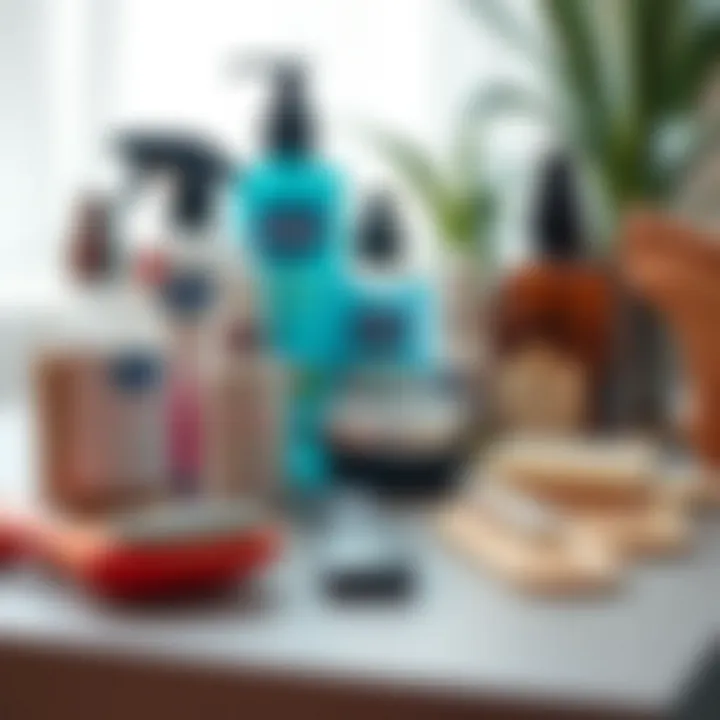
People have varying skin types, and what works like a charm for one might be a no-go for another. If you have dry, sensitive, or eczema-prone skin, you might want to tread carefully. The sharp edges of a heel scraper can irritate delicate skin, leading to excessive redness or even cuts if not handled with care. Performing a patch test—perhaps on a less sensitive area, like your elbow—could save you some trouble.
Some indications that your skin might not appreciate the scraper include:
- Redness: If your feet turn beet red after scraping, it might be a sign of irritation.
- Soreness: Pain doesn’t just mean you’re doing it right, it can mean you’re doing it wrong.
- Rash or Breakouts: If you notice bumps or a rash forming, it may be time to set down the tool and reassess your approach.
The type of scraper also matters. A chemical foot peel might suit some folks better than a metal scraper. So, keep in mind your skin type and choose the tool carefully. Always apply a moisturizer after using the scraper to help soothe any potential irritation.
Injury Prevention Tips
Prevention is better than cure, right? So, let’s run through some practical tips on how to avoid injuries while using the heel scraper tool. First off, always work on clean, dry feet. Trying to scrape away hard skin while your feet are wet might lead to slipping—potentially putting your skin at risk.
Also, do not apply too much pressure when scraping. It’s not about brute force; a gentle, steady hand tends to yield better results, without causing harm. Don't hurry the process. Taking your time can help you avoid nicks and scrapes that can turn your pampering session into a painful experience.
Some key points to keep in mind include:
- Proper Angle: Hold the scraper at a 30 to 45-degree angle to your foot. This allows for effective exfoliation without undue stress on the skin.
- Short Swiping Motions: Instead of long strokes, short and controlled movements help maintain precision and reduce injury risk.
- Disinfect Your Tools: Just as you would with any grooming tool, make sure to clean the blade of your heel scraper before and after use to prevent infections.
Always remember, if something feels off, it's best to consult a podiatrist. Your health should be the priority.
By being mindful of your skin's needs and cherishing your feet, you not only enhance your beauty routine but also ensure it remains a safe and enjoyable experience. Keeping these considerations in mind can help you make the most of your heel scraping adventures.
Comparative Tools
When it comes to maintaining foot health, using a heel scraper tool is just one part of the equation. Understanding how it stacks up against other methods can greatly enhance your foot care routine. This comparative analysis sheds light on what differentiates various foot grooming tools, including pumice stones and foot files. By diving into the specifics, readers can make an informed choice about which tool fits their needs best.
Pumice Stones vs. Heel Scrapers
Pumice stones and heel scrapers are two popular tools utilized in foot care, each with unique features and advantages.
- Material: Pumice stones are composed of volcanic rock, making them naturally abrasive. In contrast, heel scrapers are typically made from stainless steel or hard plastics, providing a different kind of scraping efficiency.
- Usage: Pumice stones are often used wet, requiring some water to soften calluses during use, whereas heel scrapers often perform effectively in both dry and wet conditions. This gives heel scrapers an edge in terms of convenience.
- Effectiveness: While pumice stones can gently buff away rough patches, they may not be as effective on stubborn calluses. Heel scrapers, being sharper, can tackle thick areas more efficiently. The precision of a heel scraper tool allows for targeted removal of dead skin, which is beneficial for those with tougher foot issues.
Despite these differences, both tools have their place in foot care. Some users prefer a pumice stone for gentle maintenance, while others opt for a heel scraper for more intensive care.
"Understanding the distinction between these tools can be a game-changer for your personal grooming strategy."
Foot Files: Pros and Cons
Foot files come into play as an alternative to both pumice stones and heel scrapers, offering yet another option for foot maintenance. To help you weigh the balance of using foot files, let’s examine their pros and cons:
Pros:
- Ease of Use: Many foot files come with a handle, providing better grip and control. This is key especially for those who may struggle with maneuvering other tools.
- Multi-Faceted: Some foot files feature dual sides—one coarse and one fine—offering versatility in how you treat your feet. You can effectively address calluses with the rough side and achieve smoothness with the fine side.
- Portability: Foot files are lightweight and often come with covers, making them easy to carry around, which is ideal for those who travel frequently.
Cons:
- Durability: Some foot files, particularly those made of cheaper plastic or foam, can wear out faster than stainless steel heel scrapers. Users might find themselves needing to replace them more often.
- Limited Effectiveness on Severe Calluses: While foot files can do a decent job at smoothing out skin, they may not be as effective for users who have very thick calluses. In such cases, more robust tools may be needed.
Using the right tool depends significantly on individual needs and the specific regional conditions of your feet. Whether it’s a pumice stone, a heel scraper, or a foot file, understanding each device’s strengths can help you craft an effective foot care regimen. Taking a balanced approach to foot hygiene ensures that you keep your feet looking and feeling their best.
User Reviews and Experiences
When considering any product, real user reviews provide a window into genuine experiences and insights that typical promotional content often lacks. In the case of heel scrapers, customer feedback plays a crucial role in shaping perceptions and guiding potential buyers. It shines a light on the practical aspects of these tools, giving a well-rounded perspective that goes beyond mere specifications or marketing claims.
Understanding user reviews means looking at common themes that surface repeatedly. They can reveal how well a heel scraper performs in daily use, its durability, and even its comfort level. This is particularly important for fashion enthusiasts and stylists who may prioritize not just functionality, but also the experience of using the tool on a regular basis.
Common Feedback Themes
When we dive into user feedback, certain themes consistently emerge. Here’s a brief overview of the common comments:
- Efficiency: Many users highlight how effective heel scrapers are in removing dead skin and calluses. This feature is often praised, as it aligns with the tool's primary purpose.
- Ease of Use: Reviews commonly point to how simple it is to handle a heel scraper, especially ergonomic designs that fit comfortably in hand.
- Durability: Users frequently comment on the longevity of the product. Those who choose well-made scrapers often report satisfaction over extended periods without significant wear.
- Value for Money: Feedback often addresses pricing, comparing the benefits of investing in a quality heel scraper versus cheaper, less effective alternatives.
- Skin Sensitivity: A number of users provide insights on how the tool affects sensitive skin, which is particularly useful for those prone to irritation.
This sort of feedback serves as a collective wisdom repository, allowing potential buyers to weigh the advantages and shortcomings of a heel scraper before making a purchase.
Influencer Insights
In the world of foot care, influencers have emerged as significant voices, often shaping consumer behavior and preferences. Their endorsements can lead to heightened demand for specific brands or products, but more importantly, they often share nuanced insights that standard reviews might not capture.
Popular beauty and fashion influencers demonstrate how they integrate heel scrapers into their routines, often showcasing the before-and-after results.
Some elements influencers typically touch upon include:
- Demonstration of Technique: Many influencers provide video content, illustrating how they use a heel scraper effectively. This is valuable for visual learners who benefit from seeing methods in action.
- Product Comparison: Influencers frequently compare different heel scrapers, which can help consumers identify what might be best for their needs.
- Personal Recommendations: Their personal touch in recommending specific brands may lend credibility, given their track record of reviewing other beauty tools.
- Trending Trends: Influencers are often on the pulse of trends in foot care, relaying what’s gaining traction in the beauty community, thus helping readers stay informed.
In essence, user reviews and influencer insights work hand-in-hand to provide a rich ecosystem of knowledge regarding heel scrapers. By examining these experiences, readers can equip themselves with practical knowledge to make informed decisions about their foot care tools.
When to Seek Professional Help
Understanding when to seek professional help regarding foot care is pivotal for maintaining overall foot health. While a heel scraper tool can perform wonders in managing dead skin and calluses, it’s essential to know that certain conditions require professional intervention.
The significance of recognizing these signs benefits not just the feet but also improves overall well-being. People often overlook their foot health until it becomes an urgent issue. Acute problems can lead to long-term repercussions if not properly addressed. Here are some considerations that underline the importance of seeking help from a qualified podiatrist:
- Preventing Complications: Infections or other severe conditions can worsen rapidly without appropriate treatment.
- Understanding Underlying Conditions: Persistent foot problems may indicate systemic issues like diabetes or circulatory problems requiring medical attention.
- Personalized Care Plans: Professionals can provide tailored recommendations based on individual foot conditions and lifestyle.
"Ignoring foot problems can lead to more severe health issues. Early intervention is key."
Signs of Severe Damage
Recognizing the signs of severe damage to your feet is crucial for maintaining health and comfort. Here are some indicators that suggest it’s time to consult a professional:
- Persistent Pain: Any ongoing or intensifying pain in the feet is a signal that something isn’t right.
- Swelling or Redness: Unusual swelling or redness could indicate a serious condition, including infection.
- Cracking or Bleeding Skin: Deep cracks or any bleeding should not be taken lightly, as they can lead to complications.
- Changes in Nail Appearance: Issues such as discoloration or separation from their nail beds may point to fungal infections or other disorders.
- Loss of Functionality: If you find it difficult to walk or put weight on your feet, immediate assessment is necessary.
Consulting a Podiatrist
Engaging with a podiatrist is not merely a fallback; it’s an essential part of a comprehensive foot care routine. Podiatrists specialize in diagnosing and treating foot-related ailments, making them the go-to professionals for any alarming signs.
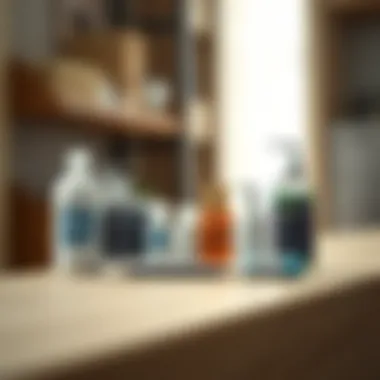

- Comprehensive Assessment: A podiatrist conducts a thorough evaluation which might include physical exams, digital imaging, or lab tests to understand the issue better.
- Treatment Options: They can offer treatments varying from custom orthotics and physical therapy to surgery if necessary. Each treatment plan is tailored to individual needs.
- Education on Care Practices: Consulting a podiatrist also provides a great opportunity for education on preventative care, ensuring that your foot health is maintained over time.
- Follow-Up Care: Regular check-ups can help keep track of foot health and catch issues before they escalate.
In summary, while heel scrapers are valuable tools for routine maintenance, they have their limitations. Recognizing when to seek professional help can safeguard your feet against serious problems, enhancing the quality of your life. Addressing issues promptly means healthier, happier feet.
Cultural Perspectives on Foot Care
Foot care is more than a mere beauty routine; it is deeply embedded in cultural practices around the globe. Each culture brings its unique approach to foot care, shaped by various factors such as climate, traditional medicine, and societal norms. Understanding these perspectives sheds light on the universal need for foot health while also appreciating the diversity in practices. This section aims to explore distinct foot care traditions and modern grooming trends, revealing the significance of the heel scraper tool within these contexts.
Foot Care Traditions Around the World
Different regions of the world boast time-honored rituals dedicated to foot care. For instance, in Japan, the practice of Shiatsu, a form of massage therapy that often includes the feet, emphasizes the holistic approach to well-being. Japanese individuals take a keen interest in maintaining foot health, often using tools like wooden foot scrapers, which are reminiscent of modern heel scrapers. The rituals surrounding foot cleansing in Japanese culture reflect a belief in the connection between clean feet and overall health.
Similarly, in Indian culture, foot care is a sacred responsibility, often associated with respect and love. Here, feet are seen as a vessel of connection; people perform rituals such as Paduka Daan, which involves the ceremonial washing and anointing of the feet. This highlights how foot care is not just personal; it can symbolize devotion and care toward others.
In contrast, Scandinavian countries show a pragmatic approach to foot care. The traditional Swedish practice of using pumice stones, often coupled with moisturizing creams, aligns well with their focus on functionality and health. The emphasis is primarily on preventing hard skin and encouraging good circulation—all integral aspects also addressed by heel scrapers.
These examples illustrate how foot care traditions encapsulate more than survival; they reveal a connection to cultural identities and values, reinforcing the need for innovation in foot care tools like heel scrapers that respect and enhance these histories.
Modern Trends in Foot Grooming
As globalization occurs, diverse foot care practices are rapidly intertwining, leading to a blending of traditions and the emergence of modern grooming trends. One prevailing trend is the increasing use of natural and sustainable products in foot care, driven by growing awareness of environmental issues. Consumers today are much more inclined to select heel scrapers crafted from sustainable materials, ensuring they contribute positively to both their health and the planet’s well-being.
Moreover, the rise of social media platforms has fostered a community where enthusiasts share experiences and product recommendations. For example, using heel scrapers has gained traction across various beauty and wellness influencers who advocate for healthy, well-groomed feet as an essential aspect of personal image. This cultural shift encourages individuals to invest time and resources in foot care, aligning with a broader societal move toward self-care and professionalism.
Furthermore, new technology-infused tools are entering the scene. Devices equipped with electric scrapers and glide functions are becoming popular, promising efficiency without sacrificing the nurturing aspect of foot care. This is particularly appealing to those with busy lifestyles who still yearn for self-care moments amidst the hustle.
Future Trends in Foot Care Tools
The landscape of foot care is experiencing a significant transformation, driven by a growing awareness of health and wellness. This section will focus on the importance of recognizing the burgeoning trends in foot care tools, particularly heel scrapers. Understanding these trends enables fashion enthusiasts, stylists, and retailers to stay ahead in a competitive market while fostering better health practices among consumers.
Innovations in Design
Foot care tools, primarily heel scrapers, are steadily becoming more innovative in their design. The shift towards ergonomics is a notable trend. Manufacturers are increasingly focusing on user-friendly designs, ensuring that tools not only perform well but also feel comfortable in the user's hand. For example, many new heel scrapers feature soft, non-slip handles that provide better grip, which is particularly beneficial for individuals with mobility issues or less strength in their hands.
Another innovation is the redesign of scraper blades. Today's heel scrapers use advanced materials that allow for a combination of gentleness and effectiveness. Many blades are made from stainless steel or high-grade plastic that can easily flex to conform to the natural curvature of the foot, preventing unnecessary discomfort or injury. These designs are not just about aesthetics; they also serve a practical purpose, helping users achieve better results with less effort.
"A well-designed foot care tool can be the difference between a pleasant self-care experience and a chore that feels like a punishment."
As people become more interested in maintaining their overall health, there's also an increasing trend toward tools that promote sustainability. Many manufacturers are now creating heel scrapers using eco-friendly materials, resonating with consumers who prioritize responsible consumption. These products are designed to not just benefit the user, but also to minimize environmental impact.
Technological Advancements in Grooming
With the influence of technology in daily life, grooming tools—heel scrapers included—are not being left behind. One emerging trend is the integration of smart technology into foot care devices. Imagine a heel scraper equipped with sensors that can assess the condition of your skin before and after use. Such advancements could monitor the effectiveness of the tool, offering real-time feedback that allows users to adjust their scraping techniques accordingly. This layer of technology can elevate the ordinary foot care routine to something more personalized and effective.
Moreover, advancements in manufacturing processes are allowing for greater precision. 3D printing technology has emerged in the realm of custom tool production, leading to tailor-made heel scrapers that can account for the unique contours of an individual’s feet. This is particularly useful for those who may have specific foot conditions or sensitivities.
In addition to smart technology, mobile applications that accompany foot care devices are becoming popular. These apps can track progress, provide personalized grooming tips, and even set reminders for regular maintenance. As people become busier, having a digital assistant to help manage foot care routines could prove invaluable in promoting consistency.
As we look towards the future, the synergy of design innovations and technological advancements will continue to redefine the world of foot care tools. The focus will be on creating products that not only meet the physical needs of users but also align with their environmental values and lifestyle preferences.
Sustainability in Foot Care Products
In today’s world, where sustainability has morphed from a buzzword into a way of life, evaluating the environmental impact of products we use daily is more crucial than ever. Shoes wear out, and heel scrapers come to the rescue of our tired feet. But what about the tools we use for maintaining those feet? A keen focus on sustainability can drive our choices towards brands and products that not only care for our feet but also the planet.
Utilizing products made from sustainable materials aligns foot care with ecological responsibility. It’s not just about looking good; it’s about being good stewards of our environment. Sustainable foot care products, including heel scrapers, often feature biodegradable materials, which minimize waste and reduce our carbon footprint.
Some key benefits of incorporating sustainability into foot care tools include:
- Reduced Environmental Impact: Utilizing eco-friendly materials helps decrease reliance on fossil fuels and harmful chemicals. This shifts the balance towards a healthier planet.
- Promoting Ethical Brands: Many sustainable brands prioritize ethical sourcing and fair labor practices. Supporting these businesses sends a message that consumers care about how products are made.
- Long-lasting Durability: Products designed with sustainability in mind often incorporate quality craftsmanship. This means they may last longer, leading to fewer replacements and less waste.
Engaging with sustainability in foot care doesn’t just enhance your routine; it lays the groundwork for a future where beauty and functionality go hand-in-hand with environmental care.
Eco-Friendly Material Options
Selecting eco-friendly materials is essential to fostering sustainability in heel scrapers and other foot care tools. Several options stand out:
- Bamboo: This fast-growing grass is not only strong and durable but also biodegradable. Heel scrapers made from bamboo can be an excellent choice for the environmentally conscious.
- Recycled Plastics: Many companies are now producing tools from recycled materials. This not only helps reduce plastic waste but also promotes more sustainable resource use.
- Natural Rubber: A more sustainable option compared to synthetic alternatives, natural rubber is biodegradable and derived from rubber trees, making it a better option for foot care products.
- Ceramic: While not as common as other materials, ceramic tools can be made without harmful chemicals. They are often durable and long-lasting, adding to their sustainability credentials.
- Wood: Sustainably sourced wood, like from FSC certified forests, offers a natural, biodegradable alternative that can add an artisanal touch to the design.
These choices allow consumers to make informed decisions about the tools they use, potentially positively affecting the ecosystem.
Responsible Consumption Practices
Being mindful of how we consume can significantly impact the sustainability landscape. Here are some practices to consider:
- Opt for Quality Over Quantity: Investing in a high-quality heel scraper may have a higher upfront cost, but it pays off in longevity. One durable product can replace multiple cheaper ones in the long run.
- DIY Repair: Before tossing an old scraper, consider repairing it if it’s a viable option. This not only extends the tool's life but also reduces waste.
- Participate in Take-back Programs: Certain brands offer programs where customers can return used products for recycling or repurposing. This helps keep materials out of landfills and fosters a circular economy.
- Educate Others: Share knowledge about sustainable practices with friends and family. The more people understand the importance of eco-friendly choices, the more we can drive change collectively.
- Support Local Brands: Local products often have a smaller carbon footprint and can support the community's economy, making the consumption cycle more sustainable.
By harnessing responsible consumption practices and prioritizing sustainable tools, the journey towards comprehensive foot care becomes aligned with broader ecological goals, paving the way for a healthier planet as well as healthier feet.
"Sustainability is not a trend; it's a mindset that can reshape industries and empower consumers to take action."
For additional insights on sustainable practices in consumer goods, consider exploring resources from organizations such as Environmental Protection Agency, Green America, and academic publications through Google Scholar.
Incorporating these sustainable practices into your foot care regime not only enhances personal well-being but supports the Earth. It's a win-win!
Epilogue on the Heel Scraper Tool
The heel scraper tool might seem like a simple instrument, yet its implications for foot care are profound. It offers a blend of practicality and aesthetic improvement, ensuring that feet not only feel good but also look neat. Regularly incorporating this tool into your foot care regime supports healthy skin, enhances comfort, and boosts confidence, making it an invaluable addition to personal grooming routines.
Summary of Key Takeaways
- Purpose of Heel Scrapers: These tools effectively remove dead skin and reduce calluses on the heels, contributing significantly to foot health.
- Usage Best Practices: Proper techniques, such as scraping on dry skin and following up with moisturizers, maximize benefits while minimizing risks.
- Maintenance Importance: Keeping the scraper clean and in good condition ensures it remains effective and safe for long-term use.
- Potential Risks: Awareness of skin sensitivity and knowledge of when to consult a professional can prevent injuries.
As the understanding of foot care evolves, tools like the heel scraper become essential not just for personal hygiene, but as part of a larger approach to self-care and wellness.
Final Thoughts on Foot Care
Foot care is often overlooked, yet it plays a vital role in overall health and well-being. The state of our feet influences our posture, mobility, and even self-esteem. By integrating tools like heel scrapers into one’s routine, individuals can take significant strides toward better foot health.
Moreover, with trends leaning towards natural and eco-friendly products, the heel scraper tool should be seen not only as a functional implement but also as a step towards sustainable grooming. As you ponder your foot care methods, consider the scraper as an ally in the quest for healthy, comfortable, and visually appealing feet.
In sum, the heel scraper tool is more than a hygiene tool—it's a gateway to enhancing the health of our feet, making it a worthwhile investment for anyone serious about their foot care routine.















